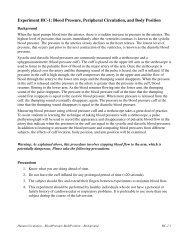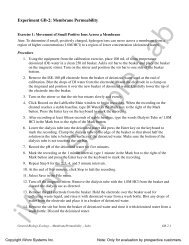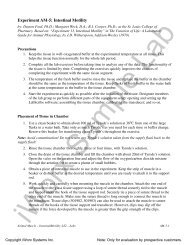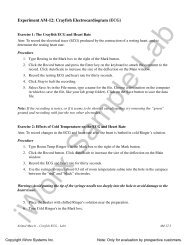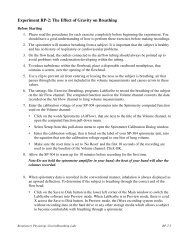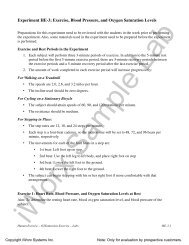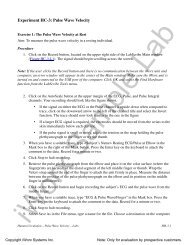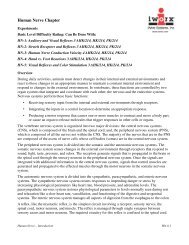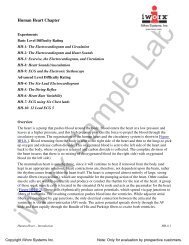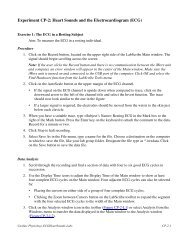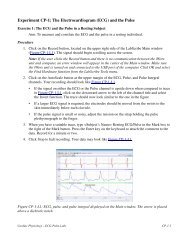Experiment HM-5: Flexibility and Range of Motion (ROM) - iWorx
Experiment HM-5: Flexibility and Range of Motion (ROM) - iWorx
Experiment HM-5: Flexibility and Range of Motion (ROM) - iWorx
- No tags were found...
Create successful ePaper yourself
Turn your PDF publications into a flip-book with our unique Google optimized e-Paper software.
3. Click the Record button in the upper right corner <strong>of</strong> the LabScribe Main window. Click on theMark button or press the Enter key on the keyboard to label the recording.4. While the subject’s arm is in the extended position, type Flexion in the Mark box.5. Instruct the subject to slowly flex his or her elbow by bringing the forearm as close to the upperarm as possible. When the subject’s elbow reaches the flexed position, click on the Mark buttonor press the Enter key on the keyboard to label the recording.6. While the subject’s elbow is in the flexed position, type Extension in the Mark box.7. Instruct the subject to fully extend his or her forearm. When the subject’s arm reaches theextended position, click on the Mark button or press the Enter key on the keyboard to label therecording.8. Repeat Steps 5 through 8 for two more cycles <strong>of</strong> flexions <strong>and</strong> extensions.9. Click Stop to halt the recording.10. Select Save in the File menu.Warning: Not everyone can hyperextend their elbows. Subjects who cannot hyperextend their elbowsshould not attempt this optional exercise.11. Optional Exercise: Ask the subject if he or she can hyperextend the elbow past 180 degrees. Ifhe or she can, use the same techniques used in Steps 2 through 8 to measure the range <strong>of</strong> motion<strong>of</strong> the subject’s elbow as it undergoes hyperextension.Data Analysis1. Scroll through the recording <strong>and</strong> find the section <strong>of</strong> data recorded from the elbow.2. Use the same techniques used in Exercise 1 to measure <strong>and</strong> record the angles <strong>of</strong> extension(Value1), flexion (Value2), <strong>and</strong> range <strong>of</strong> motion (V2-V1) during flexion <strong>and</strong> hyperextension.3. Select Save from the File menu.4. Determine the averages <strong>of</strong> the angles <strong>of</strong> extension, flexion, <strong>and</strong> range <strong>of</strong> motion for the elbow.Record the averages in the Journal <strong>and</strong> Table <strong>HM</strong>-5-L1Questions1. What anatomical parameters allow the elbow joint to be hyperextended, but not the wrist?2. Would holding a weight have any effect on the way the elbow flexes or extends?3. Compare your subject’s values to those on Table <strong>HM</strong>-5-L3. How does your subject compare tothese known values?<strong>iWorx</strong> Sample LabHuman Muscle – <strong>Flexibility</strong><strong>ROM</strong> – Labs<strong>HM</strong>-5-6Copyright <strong>iWorx</strong> Systems Inc.Note: Only for evaluation by prospective customers.



